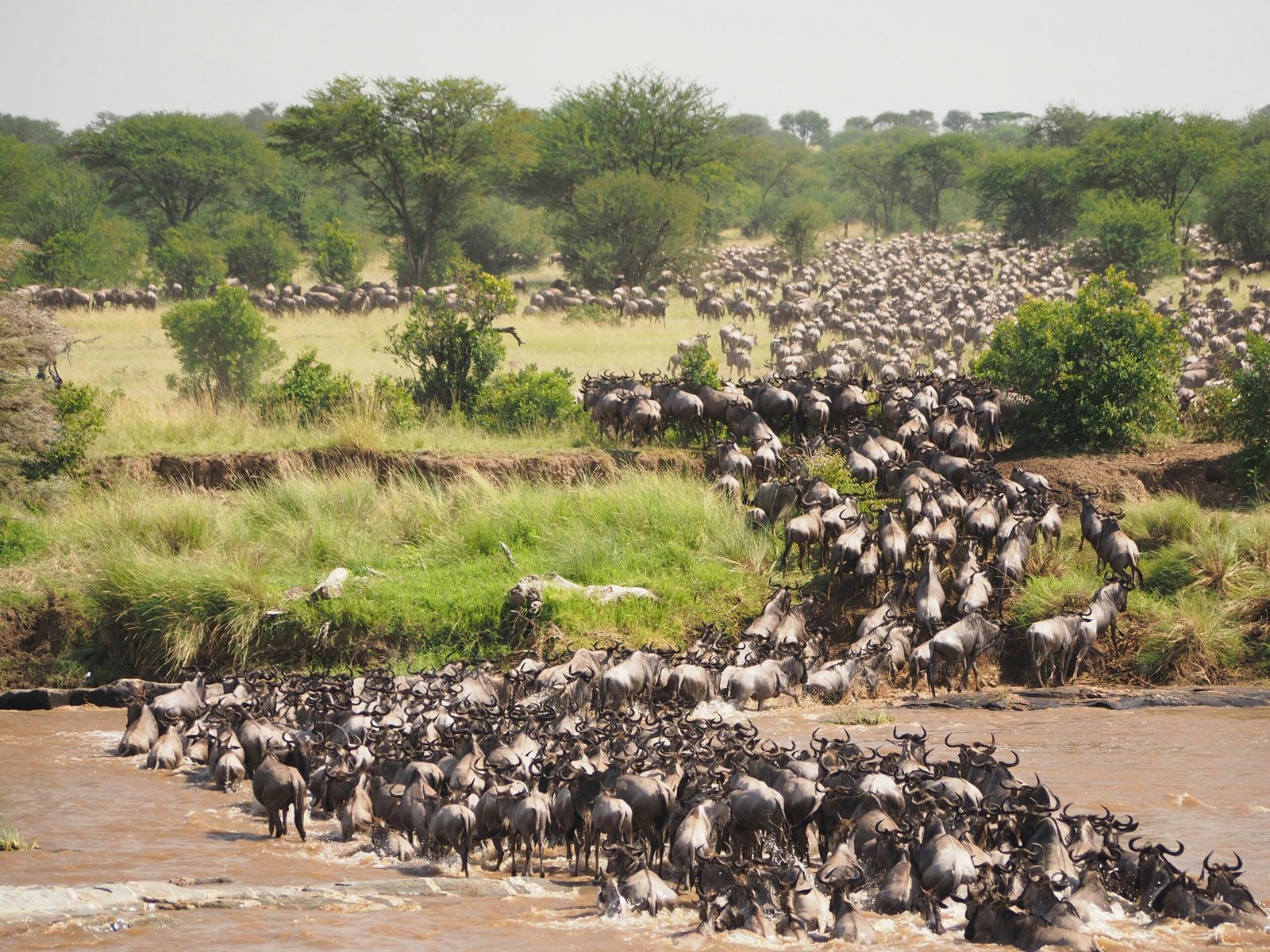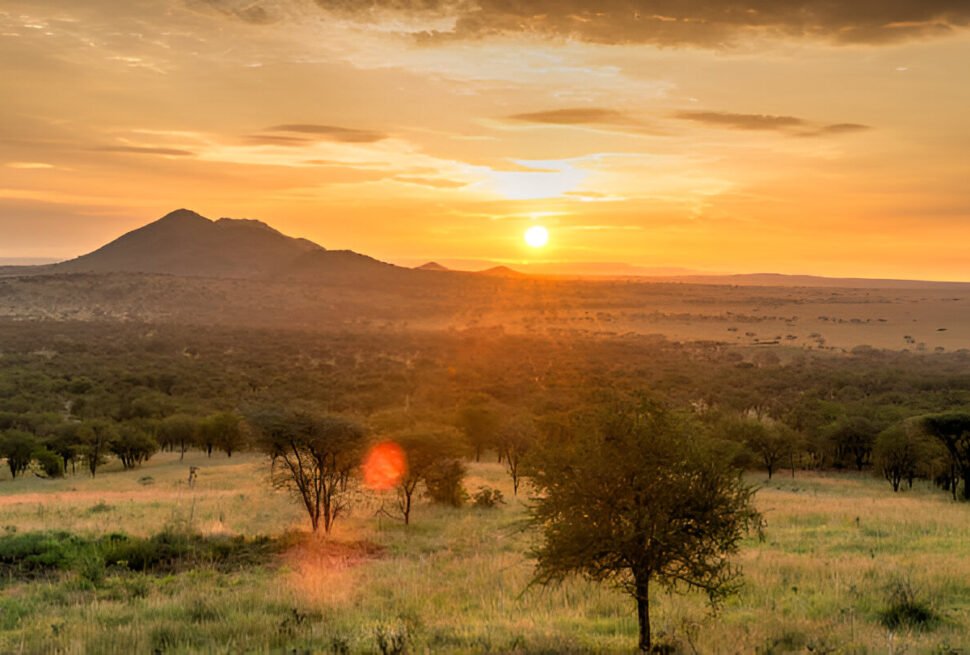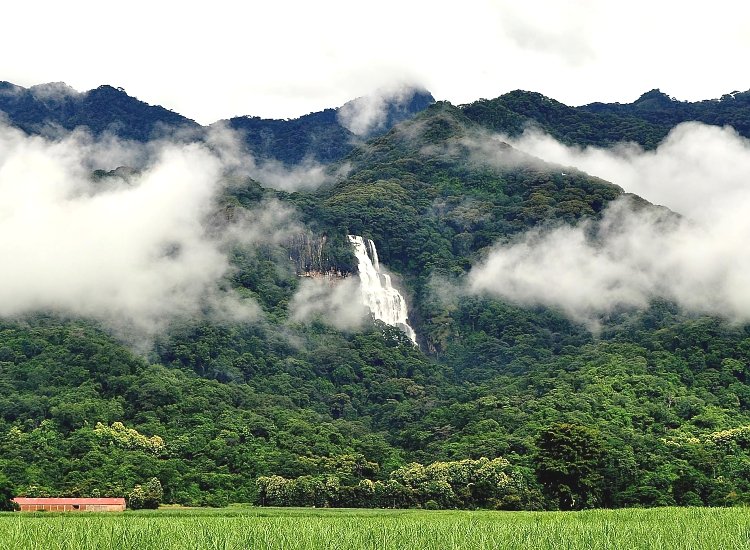Table of Contents
Introduction to the Serengeti
Serengeti National Park stands as a living testament to Africa’s wild soul—a vast, untamed expanse where the timeless rhythms of nature are on full display. For over a century, this iconic park has captured the imaginations of adventurers, conservationists, and travelers alike. With its sweeping grasslands, dramatic skies, and the breathtaking spectacle of the Great Migration, Serengeti is not just a destination; it’s an immersive journey into the heart of Africa.
In this in-depth exploration, we will delve into everything that makes Serengeti National Park the crown jewel of African safaris. From its fascinating history and unparalleled wildlife diversity to the unique experiences on offer and practical tips for planning your trip, this comprehensive guide will equip you with everything you need to know before you embark on a once-in-a-lifetime adventure.
The Legacy and History of the Serengeti
A Glimpse into the Past
The Serengeti’s story is as ancient as the land itself. Located in northern Tanzania and extending into southwestern Kenya, the Serengeti has long been a sanctuary for wildlife. Its name, derived from the Maasai word siringet, meaning “endless plains,” perfectly encapsulates the vast, undulating landscapes that stretch as far as the eye can see.
Originally inhabited by nomadic tribes who roamed these lands for millennia, the Serengeti evolved over time into a wildlife haven. In the early 20th century, European explorers and naturalists began documenting the rich biodiversity of the region, and by the 1950s, the area was officially designated a national park. This move was pivotal, as it marked the beginning of concerted efforts to conserve the natural beauty and ecological integrity of the region.
Cultural Significance
For the indigenous Maasai people, the Serengeti is more than just a picturesque landscape—it is a living part of their cultural heritage. The Maasai have coexisted with the wildlife for generations, developing a deep respect for nature and its delicate balance. Their traditional knowledge and harmonious way of life have contributed to sustainable practices that continue to influence conservation efforts today.
The park’s history is interwoven with tales of ancient battles, migration routes, and legends passed down through oral tradition. Visitors who explore the Serengeti not only witness the raw beauty of nature but also step into a world steeped in history and cultural significance.
The Unrivaled Wildlife of the Serengeti
Home to the Big Five and More
At the heart of the Serengeti experience lies its extraordinary wildlife. The park is famously home to the “Big Five”—lion, leopard, elephant, buffalo, and rhinoceros—but the list doesn’t end there. With over 70 large mammal species and a staggering array of birdlife, the Serengeti is one of the most biodiverse regions in the world.
The Great Migration
Perhaps the most awe-inspiring natural phenomenon in the Serengeti is the annual Great Migration. Each year, millions of wildebeest, accompanied by zebras and gazelles, embark on an epic journey in search of greener pastures. This incredible event, often described as one of the planet’s greatest wildlife spectacles, is a dance of life and death—where predators like lions, cheetahs, and hyenas lurk in wait, turning every moment into a high-stakes drama.
Predators and Prey in Balance
The Serengeti is a finely tuned ecosystem where predator and prey coexist in a delicate balance. Lions, known as the kings of the savanna, command respect with their regal presence. Their coordinated hunting strategies and social dynamics offer a glimpse into the complex behavior of these majestic creatures. Meanwhile, cheetahs showcase their incredible speed and agility, and leopards—ever elusive—navigate the rugged terrain with stealth and precision.
Elephants, Rhinos, and the Gentle Giants
Among the park’s most endearing inhabitants are its elephants. These gentle giants, with their complex social structures and remarkable memories, have long been a favorite of safari-goers. Similarly, the black and white rhinoceroses, though more elusive and endangered, remind us of the urgent need for conservation. Their presence serves as a stark reminder of the delicate balance between survival and extinction in today’s world.
A Birdwatcher’s Paradise
For bird enthusiasts, the Serengeti offers a veritable paradise. With over 500 species recorded, the park is a haven for ornithologists and casual birdwatchers alike. From the vibrant lilac-breasted roller to the majestic martial eagle, the avian diversity in the Serengeti is as impressive as it is colorful.
Experiencing the Safari: Game Drives, Walks, and More
Guided Game Drives
A safari in the Serengeti is synonymous with the thrill of guided game drives. These excursions, led by expert guides who possess intimate knowledge of the park’s terrain and wildlife behavior, are the best way to witness the magic of the Serengeti. Whether you’re exploring in a robust safari vehicle or a more intimate open-top jeep, each drive offers a new perspective on the landscape and its inhabitants.
The best guides are not only skilled drivers but also storytellers. They bring the history, ecology, and behavior of the wildlife to life with anecdotes, scientific insights, and personal experiences. As you traverse the seemingly endless plains, your guide will point out subtle signs—tracks, scents, and distant movements—that signal the presence of hidden wildlife. It’s a dynamic learning experience that transforms each drive into an adventure of discovery.
Walking Safaris: Getting Closer to Nature
For those seeking a more intimate encounter with the wild, walking safaris offer a unique opportunity to experience the Serengeti on foot. Led by armed guides who ensure your safety while allowing you to explore the smaller details of the ecosystem, these excursions reveal a side of the park that is often overlooked from the vehicle.
Discovering the Micro-World
Walking safaris allow you to appreciate the smaller wonders of nature: the intricate patterns of a termite mound, the delicate blossoms of indigenous wildflowers, and the subtle movements of reptiles and insects. It’s a sensory experience that heightens your awareness of the interconnectedness of all living things in the Serengeti.
Hot Air Balloon Safaris: A Bird’s-Eye View
For a truly unforgettable perspective, consider a hot air balloon safari over the Serengeti. As you drift silently above the landscape at sunrise, you’ll witness panoramic views of the vast plains, meandering rivers, and the rhythmic movement of the wildlife below. This unique experience is as serene as it is exhilarating—a peaceful prelude to the day’s adventures.
The Magic of Sunrise
There is something almost magical about watching the sunrise from a balloon. As the first rays of light illuminate the endless savanna, the landscape transforms into a canvas of gold and amber. The quiet, almost surreal, silence as you float above the earth provides a moment of reflection and wonder, setting the tone for the day ahead.
Cultural Encounters and Walking with the Maasai
The Serengeti is not only a sanctuary for wildlife but also a region rich in human culture. Many safari experiences include visits to Maasai villages, where you can learn about the traditions, lifestyles, and history of this indigenous people. These cultural encounters provide a meaningful complement to your wildlife adventures, offering insights into how the Maasai have adapted to and coexisted with the natural world for generations.
Learning from the Locals
During these visits, you might witness traditional dances, participate in storytelling sessions, or even try your hand at beadwork. The Maasai’s deep connection to the land and its creatures is evident in their daily lives, and their stories add another layer of meaning to your Serengeti experience.
When to Visit the Serengeti: Seasons and Weather
The Dry Season: Optimal Wildlife Viewing
The dry season, typically from June to October, is widely regarded as the best time to visit the Serengeti. During these months, the weather is warm and dry, and the vegetation is at its thinnest. This creates ideal conditions for game viewing, as animals congregate around remaining water sources, making them easier to spot.
Advantages of the Dry Season
- Concentrated Wildlife:
With water scarce, animals gather around rivers and waterholes, increasing your chances of witnessing dramatic predator-prey interactions. - Clear Visibility:
The reduced vegetation allows for unobstructed views of the savanna, perfect for photography and wildlife observation. - Mild Evenings:
Although daytime temperatures can be high, the evenings are pleasantly cool, providing a comfortable climate for campfires and storytelling.
The Wet Season: A Lush, Vibrant Landscape
The wet season, spanning from November to May, transforms the Serengeti into a lush, green paradise. Although the dense vegetation can sometimes make wildlife sightings more challenging, the wet season offers its own unique charm.
Highlights of the Wet Season
- The Great Migration:
The wet season is when the wildebeest and other herbivores begin their epic migration. While the herds are more dispersed, the sheer scale and beauty of the migration are awe-inspiring. - Birdwatching Bonanza:
The rains bring a burst of life to the avian population, with migratory birds adding splashes of color to the verdant landscape. - Vibrant Scenery:
The flourishing flora creates a dramatic backdrop for photography, with the interplay of light and shadow adding depth to every shot.
Transitional Periods: The Best of Both Worlds
Some travelers prefer to visit during the transitional periods between the dry and wet seasons. During these times, the landscape begins to shift, and you may experience a balance of excellent wildlife viewing combined with a touch of the lush vibrancy that characterizes the wet season. Although the weather can be more unpredictable, these shoulder months often provide a quieter, more intimate safari experience.
Accommodation Options in the Serengeti
Finding the right place to stay is crucial to your Serengeti experience. The park offers a wide range of accommodation options to suit various tastes and budgets—from luxury lodges to authentic tented camps.
Luxury Lodges and Camps
For those seeking comfort and exclusivity, luxury lodges and tented camps in the Serengeti offer an exceptional experience. These properties are often located in prime wildlife viewing areas and come with top-notch amenities, including gourmet dining, spa services, and personalized safari itineraries.
Highlights of Luxury Accommodations
- Exceptional Service:
Enjoy personalized service from experienced staff who can tailor your safari experience to your interests. - Prime Locations:
Many luxury lodges are strategically located near waterholes and migration routes, ensuring that you have front-row seats to nature’s drama. - Comfort and Convenience:
With amenities like air conditioning, comfortable beds, and even Wi-Fi in some cases, these accommodations provide a welcome retreat after a long day of adventure.
Mid-Range Options
For travelers who want an authentic safari experience without breaking the bank, mid-range lodges and camps provide a balance between comfort and affordability. These options often offer communal dining, shared facilities, and a more intimate connection with fellow travelers.
What to Expect from Mid-Range Lodging
- Cozy, Rustic Charm:
Enjoy well-appointed tents or simple lodges that capture the essence of the African bush without the frills. - Engaging Safari Programs:
Many mid-range options include guided game drives, walking safaris, and cultural excursions as part of the package. - Local Atmosphere:
Staying in these lodges often provides a closer look at local hospitality and the day-to-day life in the Serengeti.
Budget-Friendly Camps
For the intrepid traveler on a budget, the Serengeti also offers affordable camping options. Whether you’re setting up your own tent or joining a group camp, these choices allow you to experience the wild in its most raw and unfiltered form.
Benefits of Budget Camping
- Immersive Experience:
Sleeping under the vast African sky can be a transformative experience, connecting you directly with nature. - Community Spirit:
Budget camps often foster a sense of camaraderie among travelers, as you share meals, stories, and the challenges of outdoor living. - Flexible Itineraries:
With a bit of planning, budget camping can offer flexible itineraries that adapt to your interests and the whims of the wild.
Activities and Experiences Beyond Game Drives
While game drives are the cornerstone of the Serengeti experience, there are plenty of other activities that enhance your adventure and create lasting memories.
Hot Air Balloon Safaris
Drift silently above the Serengeti in a hot air balloon and witness the majesty of the savanna from an entirely new perspective. Floating over the landscape as the sun rises provides breathtaking views of the plains, waterholes, and migratory herds. This is an unforgettable experience that combines adventure with serene beauty.
Walking Safaris
For those who want to explore the finer details of the ecosystem, walking safaris are an excellent option. Led by armed guides, these excursions allow you to see the Serengeti up close—observing the smaller flora and fauna, tracking animal footprints, and learning about the intricate interdependencies of the ecosystem.
Cultural Tours
No safari is complete without an exploration of the local culture. Visit Maasai villages, attend community ceremonies, or simply enjoy traditional music and dance around a campfire. These cultural tours provide insight into how local communities coexist with the natural environment and add a rich human element to your journey.
Photography Workshops
The Serengeti’s dramatic landscapes and abundant wildlife make it a photographer’s paradise. Many safari operators offer photography workshops led by professionals who can help you capture the perfect shot—from the golden hues of sunset to the intense gaze of a predator. These workshops are ideal for both amateurs and seasoned photographers.
Bird Watching Expeditions
With over 500 bird species calling the Serengeti home, bird watching is a rewarding pursuit for nature enthusiasts. Guided bird watching expeditions will introduce you to some of the region’s most colorful and elusive avian residents, enriching your understanding of the park’s biodiversity.
Camping Under the Stars
Spend a night in the open, with the Serengeti sky above as your canopy. Budget camps and some mid-range lodges offer opportunities to camp under the stars. Enjoy the symphony of nocturnal sounds and a sky studded with stars—an experience that reconnects you with the primal rhythms of nature.
Personal Encounters
Many travelers recount the profound impact of standing in the midst of a vast herd of elephants, feeling the rumble of their movements reverberate through the ground. Others speak of the quiet moments when the only sound is the whisper of the wind through the grass, and the vast, star-studded sky overhead instills a deep sense of wonder and humility.
The Role of Local Guides
Integral to these unforgettable experiences are the local guides who share their intimate knowledge and passion for the Serengeti. Their insights into animal behavior, combined with personal anecdotes and historical context, transform each encounter into a lesson in the beauty and complexity of nature. Their expertise ensures that every moment is savored and every story, from the stealth of a stalking leopard to the communal bonds of a grazing herd, is brought to life.
The Impact of Conservation in the Serengeti
The Serengeti National Park is not only a showcase of natural beauty but also a critical battleground in the fight to preserve our planet’s biodiversity. Conservation efforts here extend far beyond protecting wildlife—they are about maintaining the delicate balance of an entire ecosystem that has evolved over millions of years.
Community and Wildlife Conservation
Local communities play a pivotal role in conservation efforts. Programs that involve the Maasai and other indigenous peoples help ensure that tourism benefits are shared, fostering a sense of stewardship for the land. These initiatives promote sustainable practices that protect the environment while supporting local livelihoods.
The Future of the Serengeti
As global challenges such as climate change and habitat loss threaten natural ecosystems, the work being done in the Serengeti serves as an inspiration and a model for conservation worldwide. By visiting the park and supporting eco-friendly tourism, travelers contribute to ongoing efforts that safeguard this iconic destination for generations to come.
Final Thoughts: Embracing the Serengeti Experience
Exploring Serengeti National Park is more than just an adventure—it’s a journey into the essence of the wild, a chance to connect with nature on a profound level, and an opportunity to witness one of the world’s most awe-inspiring natural phenomena. The combination of unparalleled wildlife encounters, breathtaking landscapes, and deep cultural connections makes the Serengeti the most iconic safari destination in Africa.




